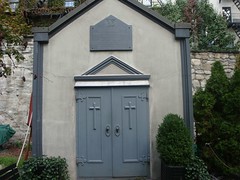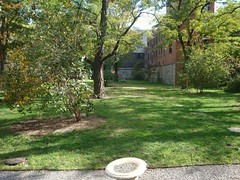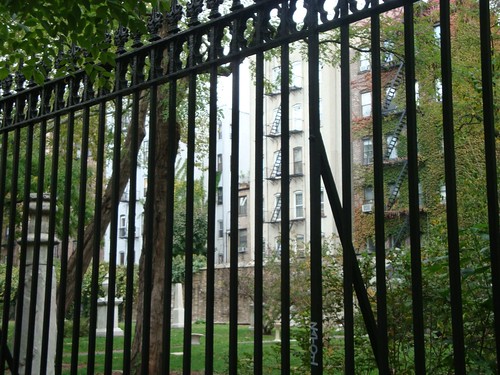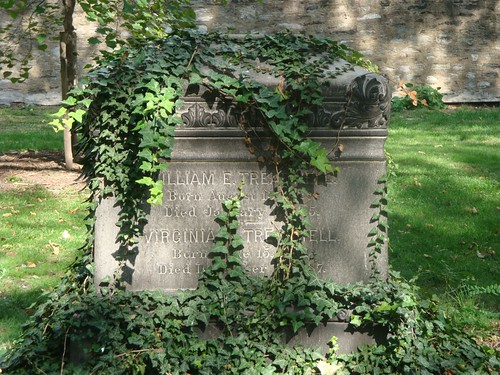 Jesse O’Neill The New York City Marble Cemetery was founded in 1831, when the Lower East Side was tracts of farmland and the city’s northern border was Grand Street.
Jesse O’Neill The New York City Marble Cemetery was founded in 1831, when the Lower East Side was tracts of farmland and the city’s northern border was Grand Street.Tucked on a sleepy stretch of East Second Street, between First and Second Avenues, the New York City Marble Cemetery is one of the oldest institutions in the neighborhood. It featured prominently in headlines earlier this month when a cache of military-grade explosives was found abandoned there in a garbage bag. Otherwise, the cemetery keeps a resolutely low profile. Closed to the public and shrouded by 250 feet of grand iron railings, it is the resting place of some four thousand souls who shaped the modern city.
On a recent visit, Colleen Iverson, the cemetery’s director, introduced me to our late neighbors. The cemetery was founded in 1831, when the Lower East Side was tracts of farmland, a retreat from the bustling city whose northern terminus was around Grand Street. As Ms. Iverson explained, the location was prime, because our 19th century predecessors believed that Second Avenue would eventually transform into a fashionable residential thoroughfare. It never quite became Park Avenue, but by the 1850’s there were eleven cemeteries in a three-block radius. New York City Marble is one of only two that remain. The other is the unrelated (despite the name) New York Marble Cemetery.
The cemetery’s prestigious reputation was solidified by an inaugural burial of American royalty. President James Monroe was laid to rest here in 1831. According to Ms. Iverson, the procession attracted 100,000 people, and was so long that when the front end arrived at the gates, the back end was just leaving City Hall. Eventually, the Founding Father’s body was moved to his native Virginia, and all that remains to mark his time here is a modest, weathered marker stone.
Many other men of influence, however, do still rest in peace under the hallowed grounds. Mayor Stephen Allen, who died in the Henry Clay Steamboat disaster in 1852 lies under this monument. The Kips of Kip’s Bay, the Booraems of Boreum Hill and the Blackwells of Blackwell (now Roosevelt) Island have family vaults here. The cemetery is non-sectarian, but is mostly filled with Protestants. There is at least one exception. Jacob Hays, a Jew, was the high constable of New York in the first half of the 18th century, before the NYPD existed. He was known as being so tough on crime that an entire department was needed to replace him.
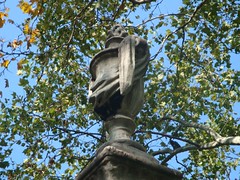 Jesse O’Neill Views of the cemetery. Its gates are open to the public twice a year. History buffs come to visit the grave marker of President Monroe.
Jesse O’Neill Views of the cemetery. Its gates are open to the public twice a year. History buffs come to visit the grave marker of President Monroe.Ms. Iverson says the cemetery is a magnet for history buffs. Many come to pay their respects to President Monroe. Civil War generals and the archeologist John Lloyd Stephens attract a lot of sightseers. Just this past Sunday, “mourners” of merchant Seabury Treadwell re-enacted his 1865 funeral by marching a coffin from his home (now the East Fourth Street Merchant’s House Museum) to his grave.
The cemetery has been resilient in surviving the growth of the East Village. In the 1890’s the trustees were alarmed by encroaching development and collected a small endowment fund to preserve the grounds. Around the turn of the century, Ms. Iverson relates that mourners had to dodge beer glasses “thrown over the high stone wall” from a Third Street Biergarden. In the 60’s and 70’s, the grounds were littered with hypodermic needles, and a man made his bed in a hammock inside the gates. Older neighborhood residents have told Ms. Iverson it was a rite of passage to climb over the imposing walls and fences for teenage high jinks, a practice obviously not condoned.
The cemetery is a protected landmark, but it receives no public money, instead subsisting mostly on donations from vault owners and supporters, along with revenue from the occasional Vogue photo session or obscure film shoot. Ms. Iverson would spend any extra money to make repairs and research unanswered questions. For example, why were three buildings erected on land that juts into the cemetery? And what information was lost when cemetery records were burned in a suspicious 1840’s fire?
Despite claims that Trinity is Manhattan’s only active cemetery, New York City Marble is still in business, with several burials in the last few years. The gates are open to the public twice a year: once in May, and during Open House New York in October. A walk through is a peaceful journey back in time that all East Villagers would be wise to take.



